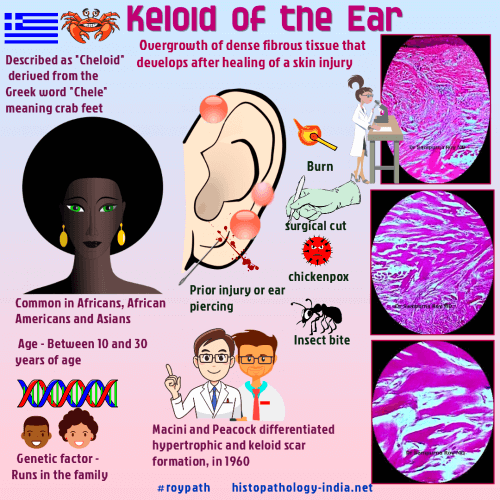|

Custom Search
|
|
Dermpath-India Keloid
|

| The term
keloid was originally described in 1800s as "cheloid," derived from the
Greek word "chele" means "crab claw." Keloids are benign cutaneous lesions that result from excessive collagen synthesis and deposition. Patients with keloid disorder carry a genetic abnormality that predisposes them to the disorder. Keloid and hypertrophic scars are two types of excessive scarring that have different therapeutic approaches. These two lesions are often confused because of an apparent lack of morphologic differences. Keloids are benign, yet locally aggressive and recurrent cutaneous fibro-proliferative condition. Keloids extend beyond the borders of the original wound invading normal skin. Hypertrophic scars do not extend beyond the initial site of injury. They're most commonly found on the chest, shoulders, earlobes, and cheeks. Earlobe keloids in particular are seen as a complication of plastic surgery or ear-piercing mainly causing cosmetic disfigurement. Keloids can also form where the skin is damaged, such as by a burn, chickenpox, insect bite or acne. Keloids of the head and neck are a relatively common entity in darker-skinned races, occurring in 5%-15% of skin wounds. Clinically they present as firm and pruritic nodules. These lesions do not regress spontaneously. Keloids are fibrotic lesions that are a result of an abnormal wound-healing process that lacks control of the mechanisms that regulate tissue repair and regeneration. Microscopic features: A thick but flattened epidermis, with broad, homogeneous, brightly eosinophilic collagen bundles are present in the deep dermis. These collagen bundles are arranged in a haphazard fashion. There is obliteration of the papillary-reticular boundary along with displacement and eventually destruction of skin appendages. Keloids are usually elevated above the the surrounding skin surface. Beneath the thin epidermis there are some some ectatic vessels and sprinkling of inflammatory cells around the vessels. In hypertrophic scar the collagen bundles and fibroblasts are arranged parallel to the skin surface. Another differential diagnosis is "keloidal dermatofibroma". In this lesion the dermatofibroma shows areas similar to keloid in the superficial portion. A keloid like change is seen as a complication of acne (acne keloidalis). Immunohistochemistry: The myfibroblasts are immunoreactive for actin, myosin and fibronectin. In keloid the proliferation of normal tissue-healing processes results in scarring that enlarges well beyond the original wound margins. Patients with a previous history of keloid or other risk-factors should avoid body piercing and elective cosmetic procedures. Keloid scars should be sent for histopathology in order to avoid missing potentially malignant conditions particularly those showing unusual features. Genes expressed specifically in keloid cells may be an adequate pathological diagnostic marker for keloids.
|
|
|


